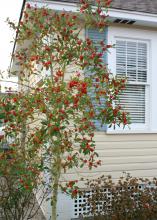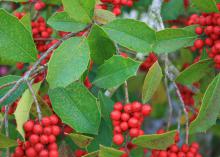Information Possibly Outdated
The information presented on this page was originally released on January 28, 2013. It may not be outdated, but please search our site for more current information. If you plan to quote or reference this information in a publication, please check with the Extension specialist or author before proceeding.
Savannah holly thrives year-round in the state
January and February are good times to see where landscapes need evergreen color to break out of the drab grays and browns of winter. When you find a spot that needs a pick-me-up, Savannah holly is a superb evergreen plant to grow in our Mississippi gardens and landscapes.
It has a natural pyramidal growth habit that is loose and open. This holly is versatile in the landscape and can be used for screening or strategically placed as single specimens.
These plants are moderate-growing large shrubs or small trees. They have the potential to reach up to 35 feet tall, but this growth will take 25 or more years. However, these hollies tolerate pruning very well if you want to maintain a specific size and structure.
Savannah holly is a hybrid of our native American holly. The trunk and side branching have a smooth texture and a light- to medium-gray color.
The foliage of Savannah holly in the summer is typically a dull, light green. The leaf margins have soft spines of varying numbers on each leaf. These spines reflect the American holly parent. When grown with other hollies that have glossy, dark green foliage like Foster’s or Nellie R. Stevens, the Savannah holly’s pale green leaves can look unhealthy, but the foliage color is perfectly normal.
During the winter months, the foliage may become a bit yellowish-purple or be tinged with red when exposed to colder temperatures. The heavy berry production can also lead to an abnormally yellow leaf color.
The berries can be a real show stopper from November through March. Tight clusters of berries form toward the ends of the branches, and these quarter-inch balls are fluorescent red. The plentiful berries are a favorite winter delicacy of birds. It is a treat to sip coffee on a cold morning and watch bright red cardinals plucking Savannah holly berries.
Savannah hollies are dioecious, meaning “of two houses,” and the species has male and female plants. Both male and female trees produce small, white flowers, but these are inconspicuous.
To have berry production, you must have both male and female hollies relatively near each other. It is a good thing that native American hollies found frequently across the state can provide the needed pollination. If you want to be sure of the best berry production, consider planting a Jersey Knight holly, which is a male American holly selection, near your Savannah hollies.
Savannah hollies tolerate almost any well-drained landscape soil. Just be sure not to plant them too deeply, keeping the top of the container even or slightly above the native soil. These plants tolerate confined root zones because they have a great number of small roots.
You can use these as street trees and achieve superb growth in tree wells. The city of Lucedale has had Savannah hollies dripping with berries lining Main Street for years.









